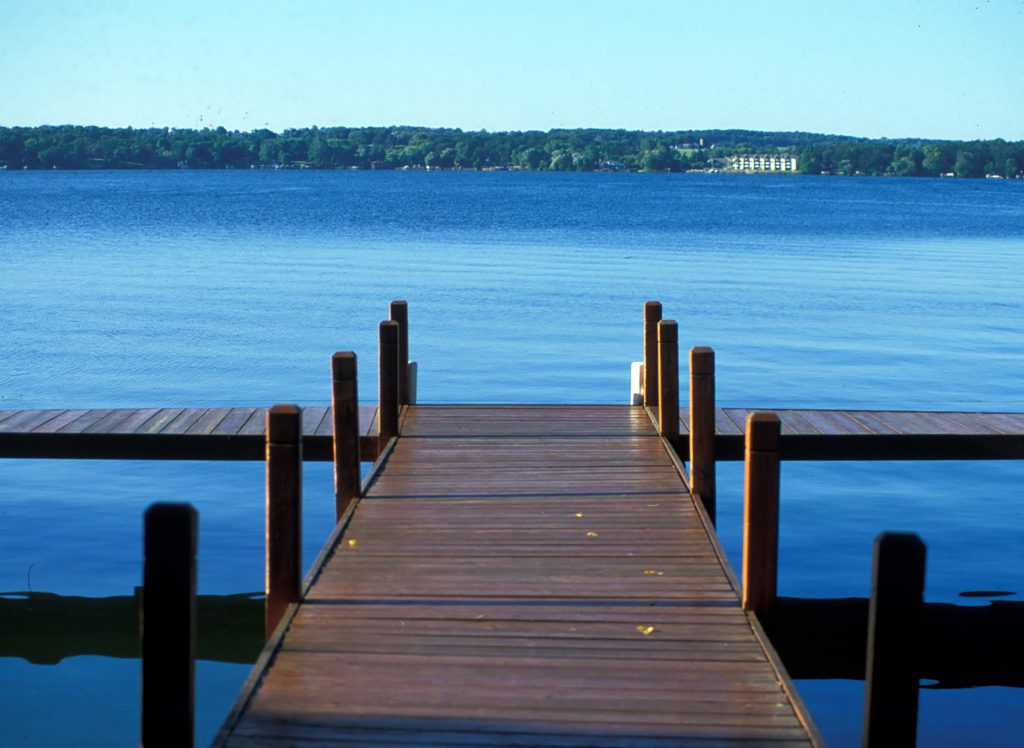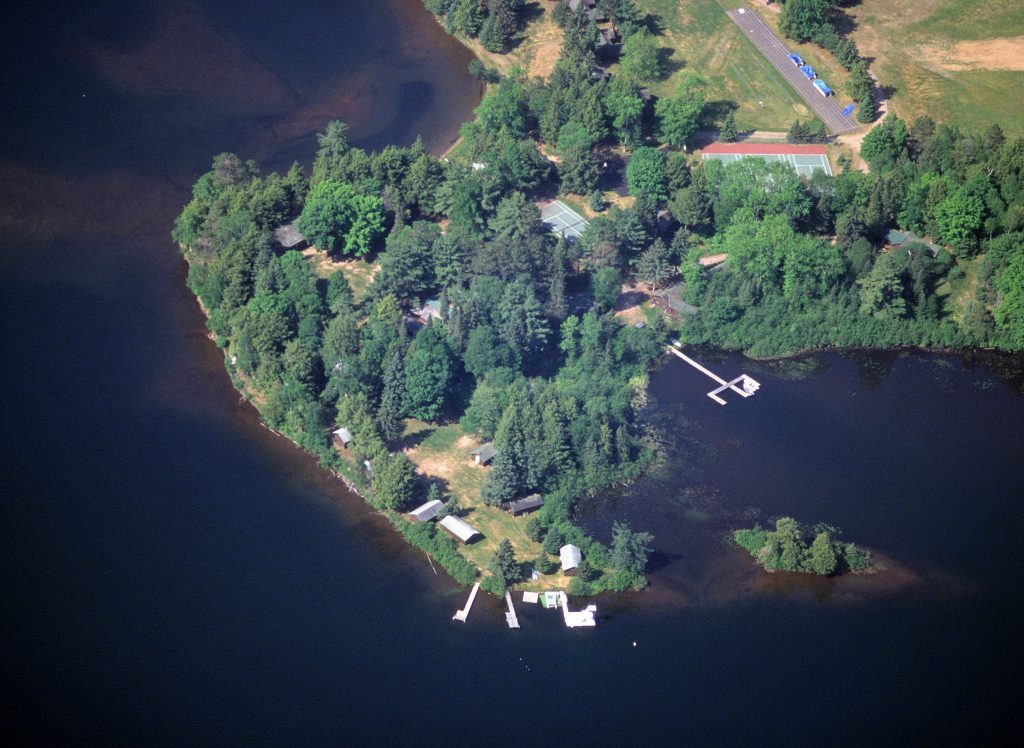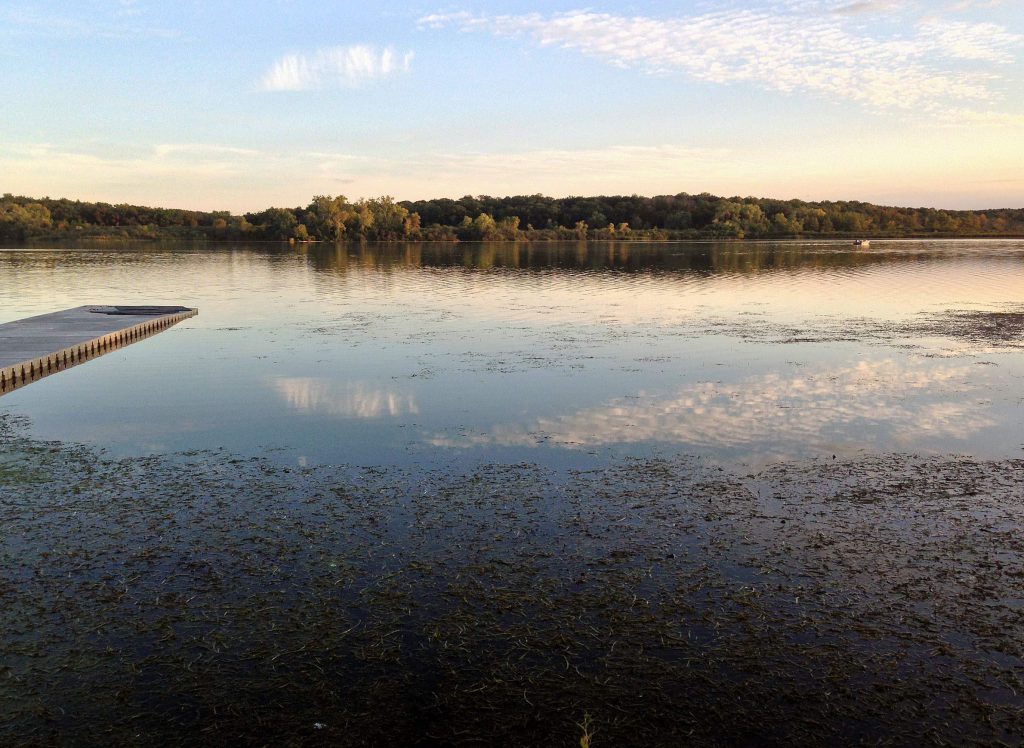What Makes A Lake Healthy?
Algal blooms, invasive species and shoreline development disrupt the healthy balance of lakes.

A pier on a Wisconsin lake. Photo from Wisconsin Department of Natural Resources (CC BY-ND 2.0).
Wisconsin is home to an awful lot of lakes. Precisely how many of these freshwater bodies of water there are in the state depends on how they’re defined and, of course, is also the subject of a long-running squabble with neighboring Minnesota. Either way, lake lovers know that the number of lakes is trivial in comparison to their quality and whether they’re able to support healthy ecosystems and the ways of life that hinge on them.
So, what defines a healthy lake? As defined by Buzz Sorge, a lake management planner for the Wisconsin Department of Natural Resources in west-central Wisconsin, a healthy lake is one whose physical, biological and chemical properties are in equilibrium. This balance provides stability that allows native aquatic organisms to flourish, Sorge explained in a March 31, 2016, talk at the Wisconsin Lakes Partnership Convention recorded for Wisconsin Public Television’s University Place.
While it may be obvious when a lake is polluted or impaired, how do scientists like Sorge determine if one is in balance? The answer isn’t quite as cut and dry as it might seem. That’s because not all lakes are alike. Rather, their differences, determined by variables such as their location on the landscape and where they fit into broader cycles with groundwater and weather, help set the boundaries for the types of habitats and native species they can host.
There are several broad categories of inland lakes in Wisconsin, according to Sorge, and each of them host unique aquatic communities. The lake types include seepage lakes, groundwater drainage lakes (also known as spring lakes), drainage lakes, impoundments and oxbow lakes. They’re differentiated based largely on the source and outlet of the water they hold, distinctions that often help define water quality. A lake’s water quality depends in part on the quantity and quality of the water entering it as well as the rate at which it leaves.
No matter how a lake is defined, attributes like maximum depth, water temperature, stratification and shoreline development all play a role in the quality, type and health of its ecosystems, Sorge said.

Lakeshore development can adversely affect shoreline and near-shore aquatic habitats. Photo from Wisconsin Department of Natural Resources (CC BY-ND 2.0).
Most of Wisconsin’s lakes are susceptible to three major threats to their health, according to Sorge: algal blooms, aquatic invasive species and destruction of habitat.
Toxic algal blooms are often driven by nutrient pollution in a lake, Sorge explained. Excess phosphorus originates from both agricultural and urban runoff, and it can feed widespread algal blooms. Such events usually occur in late summer, but algal blooms can strike earlier when the water temperature and nutrient conditions are conducive to them. This growth depletes dissolved oxygen in the water and can kill fish. On top of that, blue-green algae is thought to cause neurotoxicity if ingested, making it dangerous for wildlife, livestock, pets and people.
Meanwhile, aquatic invasive species can damage native habitat and outcompete native species, sometimes with disastrous effects for water quality. For instance, the invasive spiny water flea (Bythotrephes longimanus) appeared in Dane County‘s Lake Mendota in 2009 and quickly transformed its food web by preying on the native zooplankton Daphnia pulicaria, which are a food source for other predatory aquatic species. The Daphnia are also an important check on algal blooms, and their reduced numbers have in recent years contributed to massive algal blooms in the Yahara lakes.
Finally, destruction of shoreline and near-shore habitat can also take a toll on aquatic life, Sorge said. This process is often instigated by development of buildings and other shoreline structures, which often transforms biodiverse native habitats into species deserts.
Shoreline development also increases runoff into lakes, Sorge added.
“Once we get to even as little as 15% of [a lakeshore] lot covered with rooftops, sidewalks, walkways, driveways, you’ve increased the mass loading of phosphorus from that parcel of land by a factor of six,” he said. “Our lakes cannot sustain these types of increased inputs if we don’t manage them.”
Key facts
- Limnology is the study of freshwater ecosystems, incorporating an understanding of biological, physical and chemical factors that influence lakes, rivers and streams.
- Wisconsin’s estimated 15,000 natural lakes and tens of thousands of miles of rivers and streams date back more than 10,000 years to the end of the last period of glaciation in the region. As the glaciers retreated, they left behind basins of gouged earth that filled with water and created lakes dotting the landscape.
- Human settlement began impacting Wisconsin’s lakes on a large scale in the mid 19th century, when most of the region’s forests were clear cut. Development around the state’s lakes, particularly for recreational purposes, didn’t become widespread until after World War II.
- Seepage lakes have no surface inlet or outlet and are recharged almost exclusively by precipitation and groundwater. They are sensitive to precipitation but often don’t see much runoff pollution given their tiny watersheds.
- Impoundments are artificially created reservoirs. These lakes are actually dammed rivers, meaning they usually have large watersheds and are therefore more vulnerable to urban and agricultural runoff pollution. Impoundments can also be prone to filling with sand or silt, depending on the sediment load of the waters entering them.
- Groundwater drainage lakes have no surface inlet, are recharged by springs and groundwater and have an outlet in the form of a stream or river. A relatively well-known example of this type of lake in Wisconsin is Lake Wingra in Dane County.
- Drainage lakes have both surface inlets and outlets. Drainage lakes often host more aquatic species but are also susceptible to watershed pollution and usually have lower water quality than closed systems or groundwater drainage lakes.
- Oxbow lakes are remnants of a meandering river that have been cut off from its course.
- The DNR’s water quality criteria for Wisconsin lakes took 30 years to develop and set limits for nutrient pollution that depend on the type of lake and what its designated use is. The criteria were established in 2011.

Lake Wingra in Madison has long suffered the ecological effects of urban development within its very small watershed. Photo from Wisconsin Department of Natural Resources (CC BY-ND 2.0).
Key quotes
- On one way to conceptualize lakes: “So when you see a lake, what you’re really looking at is the interception of that lake surface representing the ground water table in that area.”
- On the sensitivity of some lakes to precipitation: “We have [seepage] lakes in the Chippewa County forest … that their lake levels still have never recovered totally since the ’88-’89 drought.”
- On the relatively new problem of excess phosphorus in Wisconsin’s lakes: “[N]aturally, in Wisconsin, because of our parent soil materials, we did not have a lot of natural phosphorus. Our lakes in a pre-settlement condition were very, very low for the most part in phosphorus.”
- On critical near-shore lake habitat, which is sometimes destroyed by lakefront development: “That near-shore habitat we call the ‘littoral zone’ is where the light penetrates deep enough into the water to allow aquatic plants to grow shoreward from that, and then up onto the lake shore. So when we just think about that littoral zone, or the area where light penetrates deep enough to stimulate the growth of aquatic plants, over 90% of the species in any given lake are dependent on that critical habitat component for at least some component of their life history.”
- On Wisconsin’s water quality criteria for lakes and why they were developed: “Well, it’s when we have obvious water quality problems and we know they’re caused by excess nutrient loading, we need to know how clean is clean, where do we need to manage that system back to, and those goals that then directly relate to them. We have numbers that we know can protect recreational fish and aquatic life uses and those things, and also EPA said this would be a good thing for all the states to do.”
The Health Of Wisconsin’s Lakes And What Throws Them Out Of Balance was originally published on WisContext which produced the article in a partnership between Wisconsin Public Radio and Wisconsin Public Television.





















